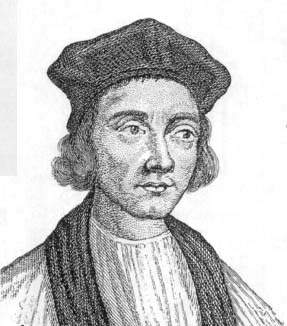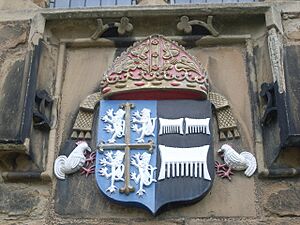Cuthbert Tunstall facts for kids
Quick facts for kids The Right Reverend Cuthbert Tunstall |
|
|---|---|
| Bishop of Durham | |
 |
|
| Church | Roman Catholic |
| Diocese | Diocese of Durham |
| Elected | 1530; 1556 |
| Reign ended | 1552; 1559 (twice deprived) |
| Predecessor | Cardinal Thomas Wolsey |
| Successor | James Pilkington |
| Other posts | Bishop of London 1522–1530 |
| Orders | |
| Consecration | 19 October 1522 by William Warham |
| Personal details | |
| Born | 1474 Hackforth, Yorkshire, England |
| Died | 18 November 1559 |
| Nationality | English |
| Parents | Thomas Tunstall |
| Alma mater | University of Oxford |

Cuthbert Tunstall (born in 1474 – died November 18, 1559) was an important English leader. He was a humanist (someone who studied human achievements), a bishop (a high-ranking church official), a diplomat (someone who represents their country), and a royal adviser. He served as the Bishop of Durham during the reigns of four different English rulers: Henry VIII, Edward VI, Mary I, and Elizabeth I.
Contents
Early Life and Education
Cuthbert Tunstall was born in 1474 in Hackforth, a village near Bedale in North Yorkshire, England. His father was Sir Thomas Tunstall. Cuthbert's half-brother, Sir Brian Tunstall, was a famous knight. He was known as the "stainless knight" and died in a battle in 1513.
We don't know much about Cuthbert's very early life. He spent two years working in the household of Sir Thomas Holland. Around 1491, he started studying at Balliol College, Oxford. There, he learned about mathematics, religion, and law. Later, he moved to King's Hall, Cambridge.
Cuthbert didn't finish his degree at Oxford or Cambridge. Instead, he went to the University of Padua in Italy. In 1505, he earned two doctorates there: one in civil law and one in church law. At Padua, he studied with leading scholars of the time. He became very good at Greek and Hebrew.
Starting His Career
In 1511, William Warham, who was the Archbishop of Canterbury, made Tunstall his chief assistant. Soon after, Tunstall became a church leader in Harrow on the Hill. By 1514, he was a canon at Lincoln Cathedral. In 1515, he became an archdeacon in Chester.
King Henry VIII and Cardinal Wolsey soon asked Tunstall to work as a diplomat. In 1515, he traveled to Flanders with Sir Thomas More. More was a famous writer and friend of Tunstall's from school. More even wrote about Tunstall in his famous book, Utopia. In Brussels, Tunstall also met Erasmus, another very important scholar. Tunstall became close friends with both More and Erasmus. He even helped Erasmus with a new edition of his New Testament.
Tunstall continued his important work. In 1516, he became the Master of the Rolls, a top legal job. In 1521, he became the Dean of Salisbury Cathedral.
Important Achievements
In 1522, Cuthbert Tunstall published the first mathematics book printed in England. It was based on the work of an Italian mathematician named Luca Pacioli.
Later in 1522, the Pope made him the Bishop of London. In 1523, he became the Lord Privy Seal, a very important government position. In 1525, he helped negotiate with Emperor Charles V. In 1529, he helped arrange the Peace of Cambrai, which was a major peace agreement.
Religious Changes and Challenges
In 1523, Tunstall met William Tyndale, who wanted support to translate the Bible into English. Tunstall did not agree to fund Tyndale's work. Later, in 1526, Tunstall oversaw the burning of many copies of Tyndale's New Testament. Tunstall believed these translations contained errors and were not approved by the church. He preferred to burn books that he considered misleading rather than punishing people.
Bishop of Durham Under Henry VIII
In 1530, Tunstall became the Bishop of Durham. This job gave him a lot of power in the area, almost like a ruler. In 1537, he became the head of the new Council of the North. He often worked on talks with the Scots and attended Parliament.
During King Henry's divorce, Tunstall advised Queen Catherine. However, unlike some others, Tunstall decided to obey the King's decisions. He accepted Henry as the head of the Church of England, even though he disagreed with some of the changes. Tunstall strongly believed in Catholic teachings.
Under Edward VI
When King Edward VI became king, his advisers made many changes to the church. Tunstall did not like these changes. He voted against the first Act of Uniformity in 1549, which changed how church services were held.
Despite his disagreements, Tunstall continued his duties. He hoped that the new leaders would change their minds about the anti-Catholic policies. But in 1551, he was called to London and kept at his house. During this time, he wrote a book about the Eucharist, a Christian ceremony. Later in 1551, he was put in the Tower of London. In 1552, he was removed from his position as bishop.
Under Mary I and Elizabeth I
When the Catholic Queen Mary I became queen in 1553, Tunstall was set free. His bishopric (his area of church leadership) was brought back, and he became Bishop of Durham again. He continued his peaceful approach and did not persecute Protestants in his diocese. He ruled his area calmly during Mary's reign.
When the Protestant Elizabeth I became queen, Tunstall faced new challenges. He refused to take the Oath of Supremacy, which would have recognized Elizabeth as the head of the Church of England. He also refused to take part in the ceremony to make Matthew Parker the new Archbishop of Canterbury for the Church of England.
Because of this, Tunstall was arrested and removed from his position as bishop again in September 1559. He was held prisoner at Lambeth Palace. He died there a few weeks later, at the age of 85. He was one of eleven Catholic bishops who died while imprisoned during Elizabeth's reign. He was buried at St Mary-at-Lambeth church.
The historian Albert F. Pollard said that Tunstall's long life and career were "consistent and honourable." He noted that Tunstall changed his mind about the king being head of the church under Edward VI, but then refused to change it again under Elizabeth.
Writings and Works
Cuthbert Tunstall wrote several important books:
- De arte supputandi libri quattuor (1522)
- This was the first math book printed in England.
- Confutatio cavillationum quibus SS. Eucharistiae Sacramentum ab impiis Caphernaitis impeti solet (Paris, 1552)
- De veritate corporis et sanguinis domini nostri Jesu Christi in eucharistia (Paris, 1554)
- Compendium in decem libros ethicorum Aristotelis (Paris, 1554)
- Certaine godly and devout prayers made in Latin by C. Tunstall and translated into Englishe by Thomas Paynelle, Clerke (London, 1558).
- Tunstall's letters and official documents from his time as president of the Council of the North are kept in the British Library.
See also
- James Stonnes (b. 1513; d. after 1585) Catholic priest, ordained by Tunstall in 1539


